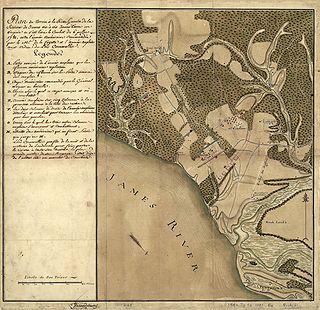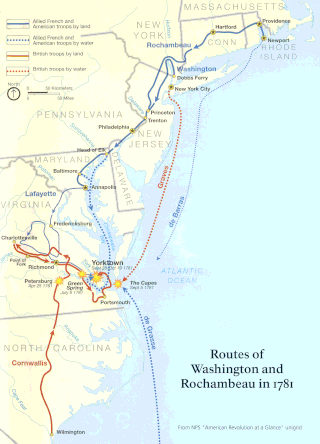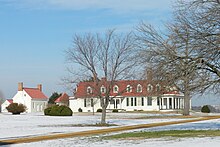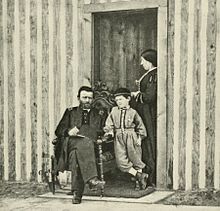Appomattox, shorthand for the surrender of Robert E. Lee to Ulysses S. Grant in the American Civil War, may refer to:

Hopewell is an independent city surrounded by Prince George County and the Appomattox River in the Commonwealth of Virginia, United States. At the 2020 census, the population was 23,033. The Bureau of Economic Analysis combines the city of Hopewell with Prince George County for statistical purposes.

Prince George County is a county located in the Commonwealth of Virginia. As of the 2020 census, the population was 43,010. Its county seat is Prince George.

Petersburg is an independent city in the Commonwealth of Virginia in the United States. As of the 2020 census, the population was 33,458 with a majority black American. The Bureau of Economic Analysis combines Petersburg with Dinwiddie County for statistical purposes. The city is 21 miles (34 km) south of the commonwealth (state) capital city of Richmond.

Colonial Heights is an independent city in the Commonwealth of Virginia. As of the 2020 census, the population was 18,170. The Bureau of Economic Analysis combines the City of Colonial Heights with Dinwiddie County for statistical purposes.

The siege of Yorktown, also known as the Battle of Yorktown and the surrender at Yorktown, began September 28, 1781, and ended on October 19, 1781, at exactly 10:30 am in Yorktown, Virginia. It was a decisive victory by a combined force of the American Continental Army troops led by General George Washington with support from Marquis de Lafayette and French Army troops led by Comte de Rochambeau and a French naval force commanded by Comte de Grasse over the British Army commanded by British Lieutenant General Charles Cornwallis.

The Appomattox River is a tributary of the James River, approximately 157 miles (253 km) long, in central and eastern Virginia, named for the Appomattocs Indian tribe who lived along its lower banks in the 17th century. It drains a cotton and tobacco-growing region of the Piedmont and coastal plain southwest of Richmond.

Appomattox Manor is a former plantation house in Hopewell, Virginia, United States. It is best known as the Union headquarters during the Siege of Petersburg in 1864–65.

The Battle of Green Spring took place near Green Spring Plantation in James City County, Virginia during the American Revolutionary War. On July 6, 1781 United States Brigadier General "Mad" Anthony Wayne, leading the advance forces of the Marquis de Lafayette, was ambushed near the plantation by the British army of Earl Charles Cornwallis in the last major land battle of the Virginia campaign prior to the Siege of Yorktown.

Petersburg National Battlefield is a National Park Service unit preserving sites related to the American Civil War Siege of Petersburg (1864–65). The battlefield is near the city of Petersburg, Virginia, and includes outlying components in Hopewell, Prince George County, and Dinwiddie County. Over 140,000 people visit the park annually.

In 1836, the Virginia House of Delegates approved a charter for the City Point Railroad. City Point, Virginia, was just ten years old. The Lower Appomattox Company ran boats of cargo from Petersburg, Virginia, to the large port at City Point. The company knew that the port needed a rail road to be competitive in the 1830s even though this would only be the second rail road in Virginia. Large ships that were too large for Port Walthall or Petersburg had to load and unload at City Point. Goods for export arrived in Petersburg from farms and plantations by way of the Upper Appomattox Canal Navigation System. The Richmond and Petersburg Railroad bringing coal and goods to port was also chartered in 1836. Coal arriving by boat from the Clover Hill Pits in 1837 and goods would soon be taken on the Clover Hill Railroad to connect with the Richmond and Petersburg Railroad to export from the area ports.
Grant's Headquarters at City Point is a museum operated by the National Park Service at Appomattox Manor in Hopewell, Virginia. It is a unit of the Petersburg National Battlefield Park.

The Tri-Cities of Virginia is an area in the Greater Richmond Region which includes the three independent cities of Petersburg, Colonial Heights, and Hopewell and portions of the adjoining counties of Chesterfield, Dinwiddie, and Prince George in south-central Virginia. Other unincorporated communities located in the Tri-Cities area include Ettrick, Fort Gregg-Adams, and City Point, the latter formerly a historic incorporated town which was annexed to become part of the City of Hopewell.

The Yorktown campaign, also known as the Virginia campaign, was a series of military maneuvers and battles during the American Revolutionary War that culminated in the siege of Yorktown in October 1781. The result of the campaign was the surrender of the British Army force of General Charles Earl Cornwallis, an event that led directly to the beginning of serious peace negotiations and the eventual end of the war. The campaign was marked by disagreements, indecision, and miscommunication on the part of British leaders, and by a remarkable set of cooperative decisions, at times in violation of orders, by the French and Americans.

The Battle of Blandford, also called the Battle of Petersburg, took place near Petersburg, Virginia on 25 April 1781, late in the American War of Independence. Roughly 2,300 British regulars under the command of Brigadier General William Phillips defeated about 1,000 militia under Major General Baron von Steuben.

The Battle of Spencer's Ordinary was an inconclusive skirmish that took place on 26 June 1781, late in the American Revolutionary War. British forces under Lieutenant Colonel John Graves Simcoe and American forces under Colonel Richard Butler, light detachments from the armies of General Lord Cornwallis and the Marquis de Lafayette respectively, clashed near a tavern at a road intersection not far from Williamsburg, Virginia.

Charles, Earl Cornwallis (1738–1805) was a military officer who served in the British Army during the American War of Independence. He is best known for surrendering his army after the 1781 siege of Yorktown, an act that ended major hostilities in North America and led directly to peace negotiations and the eventual end of the war.

The military career of Benedict Arnold in 1781 consisted of service in the British Army. Arnold had changed sides in September 1780, after his plot was exposed to surrender the key Continental Army outpost at West Point. He spent the rest of 1780 recruiting Loyalists for a new regiment called the American Legion. Arnold was then sent to Virginia with 1,600 men in late December by General Sir Henry Clinton, with instructions to raid Richmond and then establish a strong fortification at Portsmouth.

The history of Virginia in the American Revolution begins with the role the Colony of Virginia played in early dissent against the British government and culminates with the defeat of General Cornwallis by the allied forces at the Siege of Yorktown in 1781, an event signaled the effective military end to the conflict. Numerous Virginians played key roles in the Revolution, including George Washington, Patrick Henry, and Thomas Jefferson.

Violet Bank is a historic plantation house and museum in Colonial Heights, Virginia. It was listed on the National Register of Historic Places in 1974.


























